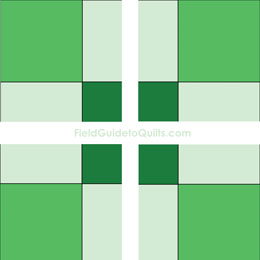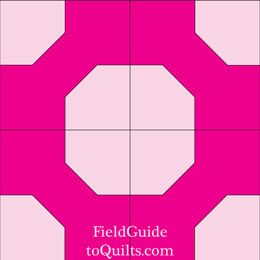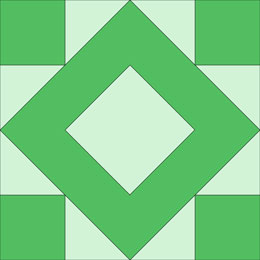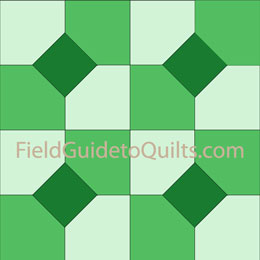| FieldGuidetoQuilts.com |
 Other square blocks
*** Other square blocks
***
|
Click on an icon to go directly to the block you're interested in.
 Susannah Patch
Susannah Patch James-town Square
James-town Square The Corner-stone
The Corner-stone True Lovers' Knot
True Lovers' Knot Necktie
NecktieNecktie
 Tic Tac Toe
Tic Tac Toe Crazy House
Crazy House Temple Court
Temple Court  Kitty Corner
Kitty Corner Crow's Foot
Crow's Foot| Box: Cut & Turn Blocks: |
 Disappear-ing 9 Patch
Disappear-ing 9 PatchSee also:
 Magic Circle
Magic CircleArt Square
















Art Square
 Art Square
Art SquareLadies Art Company,
No. 324, 1897 Village Square/Dottie's Choice
While the Ladies Art Company published Art Square in 1897 (#324), it was as Village Square that Nancy Cabot introduced this block in a 1937 Chicago Tribune. Farm Journal & Farmer's Wife called it Dottie's Choice in 1945; and finally, Doris Hinson named it Four Square in her 1973 book A Quilter's Companion.
The block would make a great signature quilt, or it could serve as a canvas for elaborate embroidery or quilting.
Diversion Quilt
 Diversion Quilt
Diversion Quilt Diversion Quilt
Diversion QuiltKCS, 1945
 This simple block with a mitered border got its name because it's so easy to make, according to the
Kansas City Star, which published it in 1945. Nevertheless, we've included instructions with the diagram you'll see when you click on the Make It! icon at right.
This simple block with a mitered border got its name because it's so easy to make, according to the
Kansas City Star, which published it in 1945. Nevertheless, we've included instructions with the diagram you'll see when you click on the Make It! icon at right. The block is a 5-patch (drawn on a 5 x 5 grid).
Sun Rays
















Sun Rays
 Sun Rays
Sun RaysTwin Fibers
 Sun Rays is a popular modern block developed by Twin Fibers, a two-woman design company. We've included it with their permission. To see Twin Fibers' blog tutorial on how to make the block, click on the icon at right.
Sun Rays is a popular modern block developed by Twin Fibers, a two-woman design company. We've included it with their permission. To see Twin Fibers' blog tutorial on how to make the block, click on the icon at right. For the traditional star block called Sun Rays, click here:
Four Four Time
 Four Four Time
Four Four Time
 Four Four Time
Four Four TimeFarm Journal & Farmer's Wife, ca. 1941 Four Four Time is a musical term that spells out the beat in a melody; it means that every fourth beat is a little bit louder than the other three.
The block was in Farm Journal and Farmer's Wife around 1941, according to Jinny Beyer's Quilter's Album of Patchwork Patterns.
Fort Sumpter/Fort Sumter
 Fort Sumpter/Fort Sumter
Fort Sumpter/Fort Sumter  Fort Sumpter [sic]
Fort Sumpter [sic]Cabot, 1937 The Civil War began at Fort Sumter, but quilt-block designer Nancy Cabot added a "p" when the block was published in the Chicago Tribune in 1937.
We quilters are such good girls that we have preserved that errant "p" in every re-publication of the block for 75 years and counting, with "[sic]" added so nobody thinks it was us who goofed.
Perhaps we should ask the President to proclaim that it's finally okay to spell the name so it matches Civil War history. No less an authority would do.
Susannah Patch















 Susannah Patch
Susannah Patch  Susannah Patch
Susannah PatchLAC, 1922
Mr. Roosevelt's Necktie was the original name (Practical Needlework,1906), but the moment the Ladies Art Company published it in 1922 (#485), this block belonged to Susannah.
The LAC's Susannah Patch became Susannah in the Kansas City Star in 1929, Susannah's Patch in 1936 (Nancy Cabot, Chicago Tribune), and Oh Susannah sometime in the 1930s, when Carrie Hall included it in her collection of quilt blocks, which is now in the Spencer Museum of Art.
Jamestown Square
 Jamestown Square
Jamestown Square  Jamestown Square
Jamestown SquareCabot, 1938
 According to Nancy Cabot, whose Chicago Tribune column first published this block in 1938, Jamestown Square dates back to 1839 and hails from Virginia.
According to Nancy Cabot, whose Chicago Tribune column first published this block in 1938, Jamestown Square dates back to 1839 and hails from Virginia.The block now seems as lost as the Roanoke Colony. We didn't find how-to instructions on the Web, so we posted a diagram. Click on the "Make it!" icon above.
Our diagram is based on Jinny Beyer's Quilter's Album of Patchwork Patterns.Our color arrangement is based on Barbara Brackman's Encyclopedia of Pieced Quilt Patterns.
The Cornerstone















 The Cornerstone
The Cornerstone  The Cornerstone
The CornerstoneKansas City Star
Dec. 22, 1942
In the New Testament, Jesus quotes a prophesy from an Old Testament psalm: "The stone that the builders rejected has become the cornerstone." He was referring to Himself, and this block name refers to Him.
True Lovers' Knot
















True Lovers' Knot in three colors
















True Lovers' Knot in two colors
 True Lovers' Knot
True Lovers' KnotLAC #262
1897
 True Lovers' Knot
True Lovers' KnotLAC #262
1897
One thing sure: The three-color variation has wound up on a lot of tile floors.
Necktie & Colonial Necktie
 Necktie
NecktieLAC, #119
1897
1932
The LAC published a quarter block of True Lovers' Knot in the same 1897 catalog and called it Necktie. It went by Peekhole in a 1931 Woman's World magazine. The mockup for the three-color True Lovers Knot serves for the mockup for this block as well.
Bow Tie/Necktie Pattern/The Necktie
A basic block picks up many names and many variations. The block at near left, which is drafted on a 6x6 grid, is known as Colonial Bow Tie (1932)—as well as Bow Tie (1970), Necktie Pattern (1935), and The Necktie (1956, Kansas City Star).
Tic Tac Toe















 Tic Tac Toe
Tic Tac Toe Tic Tac Toe
Tic Tac ToePage, 1935
Nancy Page of the Birmingham News was credited with this block in 1935. It was published the same year under the name Tile Puzzle in Hall's The Romance of the Patchwork Quilt in America.
Crazy House















 Crazy House
Crazy House Crazy House
Crazy HouseLAC, 1922
Crazy House was in a 1928 catalog from the Ladies Art Company as #516. It's based on a 5x5 grid. As for Z Cross, the name came along in 1973 when it was published in A Perfect Patchwork Primer (Gutcheon).
It's hard to know what to make of this block, but it creates a pretty double lattice with both vertical/horizontal and diagonal patterns. It's an oddity that it shares with The Bat
Hull's Victory















 Hull's Victory
Hull's Victory Hull's Victory
Hull's VictoryStone, 1906
 This eight-patch block is #73 in Clara Stone's 1906 Practical Needlework.
This eight-patch block is #73 in Clara Stone's 1906 Practical Needlework.The name is probably much older. Isaac Hull was captain of the Navy ship U.S.S. Constitution. In 1812 the Constitution won a sea battle against a British frigate named Guerriére. In 20 minutes of furious cannon fire, the Constitution's 21-inch-thick hull kept it afloat while it dismasted and destroyed the British ship.
You might say that there were two victorious hulls that day: the ship's and the captain.
The U.S. Navy was so new and the British Navy so formidable that Americans were delighted, inspired in a difficult time. They nicknamed the ship "Old Ironsides." They also came up with a contra dance named "Hull's Victory" and a tune called the "Constitution Hornpipe."
The Constitution is afloat to this day in Boston Harbor. It was last under sail on August 12, 2012, the 200th anniversary of her victory over Guerriére. Contra dance societies danced "Hull's Victory" to celebrate.
Temple Court
















Temple Court
 Temple Court
Temple CourtQuilter's Newsletter Magazine, 1973
 Temple Court is 161 years newer than Hull's Victory, but it follows tradition like a rabid reenactor.
Temple Court is 161 years newer than Hull's Victory, but it follows tradition like a rabid reenactor. Nothing about the block is different except the colors of four triangles. We'll leave it to you to see which ones.
Temple Court is from a 1973 Quilter's Newsletter Magazine, according to Barbara Brackman's Encyclopedia of Pieced Quilt Patterns.
The "Make it!" icons will send you to instructions for making the blocks. The blue links to Hull's Victory instructions on an external site. (It takes a while to load.) The lavender icon links to a diagram on our site that can be used for either block.
Crow's Foot















 Crow's Foot Variation
Crow's Foot Variation















 Crow's Foot
Crow's Foot Crow's Foot
Crow's FootLAC, #118
1897
 Crow's Foot
Crow's FootVariation
LAC, #118, 1897 Arrow Heads/Crowfoot
This Ladies Art Company pattern from 1897 (#118), was published as Arrow Heads in a 1935 Nancy Page column and Crowfoot in a 1937 Nancy Cabot column.
Like most LAC blocks, Crow's Foot was published in just two colors, and we've reproduced the placement of dark and light colors in the graphic at upper left.
It seems to us that the true charm of the block requires three or more colors. We can't resist showing you.
Crow's Foot is an eight-patch block.

